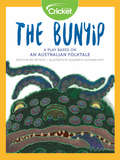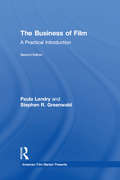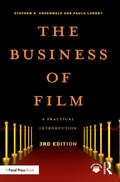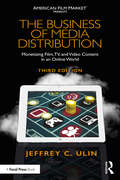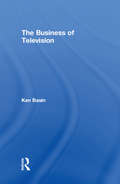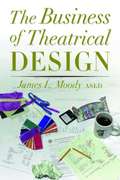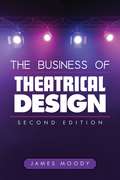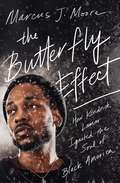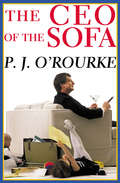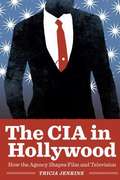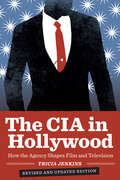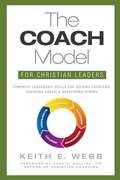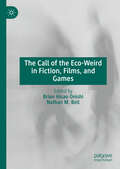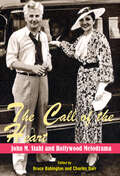- Table View
- List View
The Bunyip: A Play Based on an Australian Folktale
by Pat BetteleyIn search of food for their families, some men go hunting. When one man catches a strange creature, he ignores his fellow hunters who tell him to release the creature. The young creature's mother, eager to reclaim her baby, floods the land and turns the hunter and his people into black swans.
The Burlesque Handbook
by Jo WeldonThe Burlesque Handbook is the essential manual to understanding and performing both classic and neo-burlesque. Written by Jo Weldon, award-winning founder of the New York School of Burlesque, this book features easy-to-follow suggestions and exercises for developing stage-worthy confidence, presence, and sexiness. You'll learn about the fabulous makeup, costumes—including pasties!—moves, grooves, and attitudes of burlesque. The Burlesque Handbook is the must-have guide for everyone interested in this vibrant and wildly popular performance art, providing inspiration and practical information that readers can take straight from the page to the stage!
The Burn Cookbook: An Unofficial Unauthorized Cookbook for Mean Girls Fans
by Jonathan Bennett Nikki Martin Lacey ChabertReal Recipes to Feed Your Inner PlasticTHE BURN COOKBOOK is a hilarious, delicious must-have cookbook for chefs (and wannabes) everywhere! Jonathan Bennett (that's right, Aaron Samuels himself) dishes out a tasty parody of Mean Girls, serving up behind-the-scenes stories from the movie alongside awesome recipes for treats that your favorite mean girls should be enjoying in Girl World. Like math, the language of food is the same in every country, and this cookbook is packed with amazing creations like Fetch-uccine Alfredo, You Go, Glenn (Hot) Cocoa, and Just Stab Caesar Salad. Written with the help of rock star chef Nikki Martin, Jonathan also shares his favorite recipes from his own childhood, like his mom's famous stuffed shells, mandarin chicken salad, and other specialties that will round out any special event. Perfect for happy hour (don't forget it's from 4:00 to 6:00 PM), Wednesdays, or when sweatpants are the only thing that fits, THE BURN COOKBOOK is a must-own book for any food lover still trying making fetch happen.
The Burning (Buffy the Vampire Slayer and Angel: The Unseen Trilogy #1)
by Nancy Holder Jeff MariotteIt's summertime in Sunnydale, and Salma de la Navidad, a friend of Buffy's, needs help. She and her family immigrated to America, and now she fears her brother, in an attempt to gain social acceptance, has stumbled into supernatural gang warfare.
The Business Strategies of the Major Hollywood Film Studios (Routledge Studies in Media Theory and Practice)
by Guy Di PiazzaSurveying the strategies employed by film studios to market and produce their most successful films between 1929 and present day, this book incorporates multilayered comprehensive analysis on the media industry and how it works. Author and business strategist Guy Di Piazza draws on over 25 years of experience and provides insights into the corporate, business, market and production strategies of the leading motion picture companies through a 95- year history. Investigating the initiatives employed particularly for the most successful (or premium) films allows Guy to evaluate the commercial and creative strategies of the major film studios during four distinct historical periods: The golden age of Hollywood (1929– 1949); Hollywood in decline and in transition (1950– 1966); The new American cinema (1967– 1976); and The era of media giants (1977– 2024). With extensive business strategy analysis, this book assesses the film industry from a commercial and economic perspective to bring better understanding to readers as to how the major studios have evolved over time and what that means for today’s digitally connected world. Ideal for researchers and advanced students studying film business and the media industry, as well as professionals in the film business.
The Business of American Theatre
by William GrangeThe Business of American Theatre is a research guide to the history of producing theatre in the United States. Covering a wide range of subjects, the book explores how traditions of investment, marketing, labor union contracts, advertising, leasing arrangements, ticket scalping, zoning ordinances, royalties, and numerous other financial transactions have influenced the art of theatre for the past three centuries. Yet the book is not a dry reiteration of hits and flops, bankruptcies and bamboozles. Nor does it cover "everything about it that's appealing, everything the traffic will allow" (as Irving Berlin did in the song "There's No Business Like Show Business"). It is instead a highly readable resource for anyone interested in how money, and how much money, is critical to the art and artists of theatre. Many of those artists make appearances in the book: Richard Rodgers and his keen eye for investment, Jacob Shubert and his construction of "the bridge of thighs" for his showgirls at the Winter Garden, the significance of the Disney Souvenir Shop near the Lyceum Theatre on Broadway, and the difference between a Broadway show losing millions of dollars or making billions in one night. Consider this book a go-to resource for readers, students, and scholars of the theatre business.
The Business of Film: A Practical Introduction (American Film Market Presents)
by Paula Landry Stephen GreenwaldThe updated second edition of this text introduces readers to the business of film at every stage of the filmmaking lifecycle, from planning and production to distribution. Authors Paula Landry and Stephen R. Greenwald offer a practical, hands-on guide to the business aspects of this evolving industry, exploring development, financing, regional/global/online distribution, business models, exhibition, multi-platform delivery, marketing, film festivals, production incentives, VR/AR, accounting, and more. The book is illustrated throughout with sample financing scenarios and charts/graphics, and includes detailed case studies from projects of different budgets and markets. This new and expanded edition has further been updated to reflect the contemporary media landscape, including analysis on major new players and platforms like Netflix, Amazon, Google and Vimeo, shifting trends due to convergence and disruption from new technology, as well as the rise of independent distribution and emergent mobile and online formats. An eResource also includes downloadable forms and templates, PowerPoint slides, quizzes and test banks, and other additional resources.
The Business of Film: A Practical Introduction (American Film Market Presents)
by Paula Landry Stephen R. GreenwaldThis updated third edition introduces readers to the business of film at every stage of the filmmaking lifecycle, from planning and production to financing, marketing, and distribution. Celebrated authors Stephen R. Greenwald and Paula Landry offer a practical, hands-on guide to the business aspects of this evolving industry, exploring streaming, development, financing trends, regional/global/online distribution, shifting business models, exhibition, multi-platform delivery, marketing, VR/AR, virtual production, accounting, and more. The book is illustrated throughout with sample financing scenarios and charts/graphics, and includes detailed case studies from projects of different budgets and markets. This new and expanded edition has been updated to reflect the new challenges facing the industry due to Covid-19 and how to navigate the new landscape of film financing and distribution. Other updates include coverage of new indie films and distributors, virtual production, the recent impact of global markets including the biggest streamers like Netflix, Apple and Amazon are how they are shaping the future of the business. This is essential reading for students looking for foundational knowledge of the film industry and guidance on how to successfully adapt to constant changes in the entertainment business. Extensive online support material accompanies the book including downloadable forms and templates, PowerPoint slides, quizzes and test banks, and other additional resources.
The Business of Media Distribution: Monetizing Film, TV, and Video Content in an Online World (American Film Market Presents)
by Jeffrey C. UlinIn this updated edition of the industry staple, veteran media executive Jeff Ulin relates business theory and practice across key global market segments—film, television, and online/digital—providing you with an insider’s perspective that can't be found anywhere else. Learn how an idea moves from concept to profit and how distribution dominates the bottom line: Hollywood stars may make the headlines, but marketing and distribution are the behind-the-scenes drivers converting content into cash. The third edition: Includes perspectives from key industry executives at studios, networks, agencies and online leaders, including Fox, Paramount, Lucasfilm, Endeavor, Tencent, MPAA, YouTube, Amazon, and many more; Explores the explosive growth of the Chinese market, including box office trends, participation in financing Hollywood feature films, and the surge in online usage; Illustrates how online streaming leaders like Netflix, Amazon, Apple, YouTube, Hulu and Facebook are changing the way TV content is distributed and consumed, and in cases how these services are moving into theatrical markets; Analyzes online influences and disruption throughout the distribution chain, and explains the risks and impact stemming from changing access points (e.g., stand-alone apps), delivery methods (over-the-top) and consumption patterns (e.g., binge watching); Breaks down historical film windows, the economic drivers behind them, and how online and digital delivery applications are changing the landscape. Ulin provides the virtual apprenticeship you need to demystify and manage the complicated media markets, understand how digital distribution has impacted the ecosystem, and glimpse into the future of how film and television content will be financed, distributed and watched. An online eResource contains further discussion on topics presented in the book.
The Business of Sports Agents
by Kenneth L. Shropshire Timothy DavisThe legendary Charles C. "Cash and Carry" Pyle, considered by most to be the first sports agent, negotiated a $3,000-per-game contract for Red Grange to play professional football for the Chicago Bears in 1933. Today, salaries in the tens of millions of dollars are commonplace, and instead of theatrical promoters and impresarios, professionally trained businessmen and lawyers dominate the business. But whereas rules and penalties govern the playing field, there are far fewer restrictions on agents. Incidents of agents' manipulating athletes, ranging from investment scams to outright theft of a player's money, are far too frequent, and there is growing consensus for reformIn The Business of Sports Agents, Kenneth L. Shropshire and Timothy Davis, experts in the fields of sports business and law, examine the history of the sports agent business and the rules and laws developed to regulate the profession. They also consider recommendations for reform, including uniform laws that would apply to all agents, redefining amateurism in college sports, and stiffening requirements for licensing agents. This revised and expanded second edition brings the volume up-to-date on recent changes in the industry, including:- the closing of one of the largest agencies- high-profile personnel moves- passage of the federal Sports Agent Responsibility and Trust Act- the National Football League's aggressive and high-profile efforts to regulate agents
The Business of Television
by Ken BasinIn this book, esteemed television executive and Harvard lecturer Ken Basin offers a comprehensive overview of the business, financial, and legal structure of the U.S. television industry, as well as its dealmaking norms. Written for working or aspiring creative professionals who want to better understand the entertainment industry — as well as for executives, agents, managers, and lawyers looking for a reference guide — The Business of Television presents a readable, in-depth introduction to rights and talent negotiations, intellectual property, backend deals, licensing, streaming platforms, international production, and much more. The book also includes breakdowns after each chapter summarizing deal points and points of negotiation, a glossary, a list of referenced cases, and a wealth of real-world examples to help readers put the material into context.
The Business of Television: Updated and Expanded Second Edition
by Ken BasinIn this expanded and updated second edition, esteemed television executive and Harvard lecturer Ken Basin offers a comprehensive and readable overview of the business, financial, and legal structure of the U.S. television industry, as well as its deal-making norms.The Business of Television explores the basic structure and recent history of the television and streaming business, rights and talent negotiations, intellectual property, backend deals, licensing, international production, and much more. This expanded and updated second edition also features an in-depth exploration of the evolution of the streaming business, offers valuable new insights about negotiation, reflects the historic impacts of the 2020 Covid-19 pandemic and 2023 WGA and SAG-AFTRA strikes, addresses the intersection of artificial intelligence technology and intellectual property law, and provides a greater breadth and depth of technical material about a wide variety of common television deals. The book also includes breakdowns after each chapter summarizing major deal terms and points of negotiation, a significantly expanded glossary, an extensive list of referenced articles and cases, and a wealth of real-world examples to help readers put the material into context.Written for a diverse audience of working or aspiring creative professionals, executives, agents, managers, lawyers, and students, The Business of Television is the definitive reference guide for the ever-changing television industry.
The Business of Theatrical Design
by James MoodyFor theatrical design students and theater professionals, here is the essential guide to marketing your skills, furthering your career, and operating a successful business! In The Business of Theatrical Design, design veteran James Moody shares his proven techniques to help costume, scenic, and lighting designers become successful businesspeople. Here is the latest information regarding IRS, state, and business liabilities; salary and fee scales; equipment costs; professional organizations; union and contract issues; and much more. Plus dozens of working producers, promoters, and designers share their insights and offer a thorough, true-to-life profile of this competitive industry. An indispensable resource for anyone looking to pursue a career in the theater!
The Business of Theatrical Design, Second Edition
by James MoodyWritten by a leading design consultant and carefully updated with the latest information on the industry, this is the essential guide to earning a living, marketing skills, furthering a design career, and operating a business. With more than thirty years of backstage and behind-the-scenes experience in theater, film, television, concerts, and special events, James Moody shares his success secrets for the benefit of design students and working designers. Topics include: Finding and landing dream assignmentsNegotiating feesSetting up ideal working spacesBuilding the perfect staffOvercoming fears of accounting and record-keepingChoosing the right insuranceJoining the right unions and professional organizationsAnd more In addition to revealing how to get the great design jobs in traditional entertainment venues, the author shows designers how to think outside the box and seize creative, lucrative opportunities—such as those in theme parks, in concert halls, and with architectural firms. Providing the keys for passionate, talented designers to become successful businesspeople, The Business of Theatrical Design is a must-read for novices and established professionals alike.
The Butterfly Effect: How Kendrick Lamar Ignited the Soul of Black America
by Marcus J. MooreThis &“smart, confident, and necessary&” (Shea Serrano, New York Times bestselling author) first cultural biography of rap superstar and &“master of storytelling&” (The New Yorker) Kendrick Lamar explores his meteoric rise to fame and his profound impact on a racially fraught America—perfect for fans of Zack O&’Malley Greenburg&’s Empire State of Mind.Kendrick Lamar is at the top of his game. The thirteen-time Grammy Award-winning rapper is just in his early thirties, but he&’s already won the Pulitzer Prize for Music, produced and curated the soundtrack of the megahit film Black Panther, and has been named one of Time&’s 100 Influential People. But what&’s even more striking about the Compton-born lyricist and performer is how he&’s established himself as a formidable adversary of oppression and force for change. Through his confessional poetics, his politically charged anthems, and his radical performances, Lamar has become a beacon of light for countless people. Written by veteran journalist and music critic Marcus J. Moore, this is much more than the first biography of Kendrick Lamar. &“It&’s an analytical deep dive into the life of that good kid whose m.A.A.d city raised him, and how it sparked a fire within Kendrick Lamar to change history&” (Kathy Iandoli, author of Baby Girl) for the better.
The Butterfly Effect: How Kendrick Lamar Ignited the Soul of Black America
by Marcus Moore'Kendrick Lamar understands and employs blues, jazz, and soul in his music, which makes it startling. His work is more than merely brilliant; it is magic' Toni Morrison'Lamar is a man living on a real and metaphorical peak, with one eye trained on the heavens, the other searching for stories in the valley below' Guardian __________Kendrick Lamar has been described as the poet Laurette of hip-hop, perceptive, philosophical, unapologetic, fearless, and an innovative storyteller whose body of work has been compared to James Joyce and James Baldwin. He is a visionary who will go down as history as one of the most important artists of all time. But what's so striking about Kendrick Lamar, aside from his impressive accolades, is how he's effectively established himself as a formidable opponent of oppression, a force for change. Through his confessional poetics, his politically charged anthems, and his radical performances, Lamar has become a beacon of light for many people in America. Now, for the first time, we will be taken on a journey of Lamar's life. Told through his three albums, The Butterfly Effect gives unparalleled insight into his background, influences and the importance of his music. The book traces not only Lamar's powerful impact on music but also on our current society, especially under the weight of police brutality, divisive politics, and social injustice. With exclusive interviews with his family, friends, and record producers, this book is the must-read for any fan.
The CBS Radio Mystery Theater: An Episode Guide and Handbook to Nine Years of Broadcasting, 1974-1982
by Gordon Payton Martin GramsAlmost every evening for nine years during the late 1970s and early 1980s, the CBS Radio Mystery Theatre brought monsters, murderers and mayhem together for an hour. Created, produced and directed by Himan Brown, the series remains a landmark in radio drama. This book is a detailed history and episode guide to the show. Descriptive information includes exact titles, airdates and rebroadcast dates, episode numbers, cast lists, writer and adapter credits, and a storyline synopsis. This material comes directly from CBS press releases in order to insure complete accuracy. Also included wherever possible are information about the actors and actresses, quotes from performers and writers (many from personal interviews), anecdotes about various scripts and sound effects, and other notes of interest.
The CEO of the Sofa
by P. J. O'RourkeExperience a year in the life of a cranky couch potato—also known as &“the funniest writer in America&” (The Wall Street Journal). Touching on topics from technological change to the United Nations, this is a chronicle of the day-to-day home life and frequent harangues of a New York Times–bestselling humorist. Over the course of the year, in between rants, he does occasionally leave the sofa and embark on exotic adventures—including a blind (drunk) wine tasting with Christopher Buckley, and a Motel 6 where he has twenty-eight channels and a bathroom to himself. As readers of Parliament of Whores, Give War a Chance, and his other bestsellers know, P. J. O&’Rourke takes no prisoners—though he may take a few naps. &“An entertaining and engaging read.&” —Associated Press &“A wide-angled worldview from his own living room, his salon of sarcasm. He introduces readers to his assistant, friends, family and smart-aleck babysitter . . . His vitriolic wit is couched in humor that elicits the gamut from giggles to guffaws.&” —Publishers Weekly
The CIA in Hollywood: How the Agency Shapes Film and Television
by Tricia JenkinsWhat’s your impression of the CIA? A bumbling agency that can’t protect its own spies? A rogue organization prone to covert operations and assassinations? Or a dedicated public service that advances the interests of the United States? Astute TV and movie viewers may have noticed that the CIA’s image in popular media has spanned this entire range, with a decided shift to more positive portrayals in recent years. But what very few people know is that the Central Intelligence Agency has been actively engaged in shaping the content of film and television, especially since it established an entertainment industry liaison program in the mid-1990s. The CIA in Hollywood offers the first full-scale investigation of the relationship between the Agency and the film and television industries. Tricia Jenkins draws on numerous interviews with the CIA’s public affairs staff, operations officers, and historians, as well as with Hollywood technical consultants, producers, and screenwriters who have worked with the Agency, to uncover the nature of the CIA’s role in Hollywood. In particular, she delves into the Agency’s and its officers’ involvement in the production of The Agency, In the Company of Spies, Alias, The Recruit, The Sum of All Fears, Enemy of the State, Syriana, The Good Shepherd, and more. Her research reveals the significant influence that the CIA now wields in Hollywood and raises important and troubling questions about the ethics and legality of a government agency using popular media to manipulate its public image.
The CIA in Hollywood: How the Agency Shapes Film and Television
by Tricia JenkinsAn in-depth study of the CIA’s collaboration with Hollywood since the mid-1990s, and the important and troubling questions it creates.What’s your impression of the CIA? A bumbling agency that can’t protect its own spies? A rogue organization prone to covert operations and assassinations? Or a dedicated public service that advances the interests of the United States? Astute TV and movie viewers may have noticed that the CIA’s image in popular media has spanned this entire range, with a decided shift to more positive portrayals in recent years. But what very few people know is that the Central Intelligence Agency has been actively engaged in shaping the content of film and television, especially since it established an entertainment industry liaison program in the mid-1990s.The CIA in Hollywood offers the first full-scale investigation of the relationship between the Agency and the film and television industries. Tricia Jenkins draws on numerous interviews with the CIA’s public affairs staff, operations officers, and historians, as well as with Hollywood technical consultants, producers, and screenwriters who have worked with the Agency, to uncover the nature of the CIA’s role in Hollywood. In particular, she delves into the Agency’s and its officers’ involvement in the production of The Agency, In the Company of Spies, Alias, The Recruit, The Sum of All Fears, Enemy of the State, Syriana, The Good Shepherd, and more. Her research reveals the significant influence that the CIA now wields in Hollywood and raises important and troubling questions about the ethics and legality of a government agency using popular media to manipulate its public image.“Fascinating, highly readable . . . Overall, Jenkins’s work is fresh and original, and demonstrates sound scholarship. The author has a passion for the topic that translates to vibrant writing. It is also a concise as well as entertaining look at an aspect of the CIA—its media relations with Hollywood—of which little is known. Enthusiastically written and incorporating effective, illustrative case studies, The CIA in Hollywood is definitely recommended to students of film, media relations, the CIA, and U.S. interagency relations.” —H-War
The CIA in Hollywood: How the Agency Shapes Film and Television
by Tricia JenkinsAn in-depth study of the CIA’s collaboration with Hollywood since the mid-1990s, and the important and troubling questions it creates.What’s your impression of the CIA? A bumbling agency that can’t protect its own spies? A rogue organization prone to covert operations and assassinations? Or a dedicated public service that advances the interests of the United States? Astute TV and movie viewers may have noticed that the CIA’s image in popular media has spanned this entire range, with a decided shift to more positive portrayals in recent years. But what very few people know is that the Central Intelligence Agency has been actively engaged in shaping the content of film and television, especially since it established an entertainment industry liaison program in the mid-1990s.The CIA in Hollywood offers the first full-scale investigation of the relationship between the Agency and the film and television industries. Tricia Jenkins draws on numerous interviews with the CIA’s public affairs staff, operations officers, and historians, as well as with Hollywood technical consultants, producers, and screenwriters who have worked with the Agency, to uncover the nature of the CIA’s role in Hollywood. In particular, she delves into the Agency’s and its officers’ involvement in the production of The Agency, In the Company of Spies, Alias, The Recruit, The Sum of All Fears, Enemy of the State, Syriana, The Good Shepherd, and more. Her research reveals the significant influence that the CIA now wields in Hollywood and raises important and troubling questions about the ethics and legality of a government agency using popular media to manipulate its public image.“Fascinating, highly readable . . . Overall, Jenkins’s work is fresh and original, and demonstrates sound scholarship. The author has a passion for the topic that translates to vibrant writing. It is also a concise as well as entertaining look at an aspect of the CIA—its media relations with Hollywood—of which little is known. Enthusiastically written and incorporating effective, illustrative case studies, The CIA in Hollywood is definitely recommended to students of film, media relations, the CIA, and U.S. interagency relations.” —H-War
The COACH Model for Christian Leaders: Powerful Leadership Skills for Solving Problems, Reaching Goals, and Developing Others
by Keith E. WebbThe COACH Model® is a radically different approach to leading people. You will learn how to create powerful conversations to assist others to solve their own problems, reach goals, and develop leadership skills in the process. The COACH Model for Christian Leaders is packed with stories and illustrations that bring the principles and practice to life.
The Call of the Eco-Weird in Fiction, Films, and Games
by Brian Hisao Onishi Nathan M. BellThis edited volume identifies and analyses the Eco-Weird as an interdisciplinary theoretical tool for engaging in fictional, philosophical, filmic, and ludic texts. It is the first volume to engage in the study of the Eco-Weird, which is a developing field at the intersection of environmental thought and Weird fiction, broadly construed to include literature, games, films, art, and television shows. The Eco-Weird has intersections with other literary and scholarly fields, including horror studies, game studies, phenomenology, literary criticism, and eco-criticism, but provides a unique set of tools to engage both its texts and the ongoing environmental crises of climate change, environmental justice, pollution, and more.
The Call of the Heart: John M. Stahl and Hollywood Melodrama
by Bruce Babington Charles BarrThe profusion of research on film history means that there are now few Hollywood filmmakers in the category of Neglected Master; John M Stahl (1886–1950) has been stuck in it for far too long. His strong association with melodrama and the womans film is a key to this neglect; those mainstays of popular cinema are no longer the object of critical scorn or indifference, but Stahl has until now hardly benefited from this welcome change in attitude. His remarkable silent melodramas were either lost, or buried in archives, while his major sound films such as Imitation of Life and Magnificent Obsession, equally successful in their time, have been overshadowed by the glamour of the 1950s remakes by Douglas Sirk. Sirk is a far from neglected figure; Stahls much longer Hollywood career deserves attention and celebration in its own right, as this book definitively shows. Drawing on a wide range of film and document archives, scholars from three continents come together to cover Stahls work, as director and also producer, from its beginnings during World War I to his death, as a still active filmmaker, in 1950. Between them they make a strong case for Stahl as an important figure in cinema history, and as author of many films that still have the power to move their audiences.
The Call of the Heart: John M. Stahl and Hollywood Melodrama
by Bruce Babington and Charles BarrA study of an important but neglected director that “fills many gaps and updates our knowledge of a major filmmaker of the silent period and beyond” (Positif).The profusion of research on film history means that there are now few Hollywood filmmakers in the category of Neglected Master, but John M. Stahl has been stuck in it for far too long. His strong association with melodrama and the “woman’s film” is a key to this neglect; those mainstays of popular cinema are no longer the object of critical scorn or indifference, but Stahl has until now hardly benefited from this welcome change in attitude.His remarkable silent melodramas were either lost or buried in archives, while his major sound films such as Imitation of Life and Magnificent Obsession, equally successful in their time, have been overshadowed by the glamour of the 1950s remakes by Douglas Sirk. Sirk is a far from neglected figure; Stahl’s much longer Hollywood career deserves attention and celebration in its own right, as this book definitively shows.Drawing on a wide range of film and document archives, scholars from three continents come together to cover Stahl’s work, as director and also producer, from its beginnings during World War I to his death, as a still active filmmaker, in 1950. Between them they make a strong case for Stahl as an important figure in cinema history, and as author of many films that still have the power to move their audiences.
